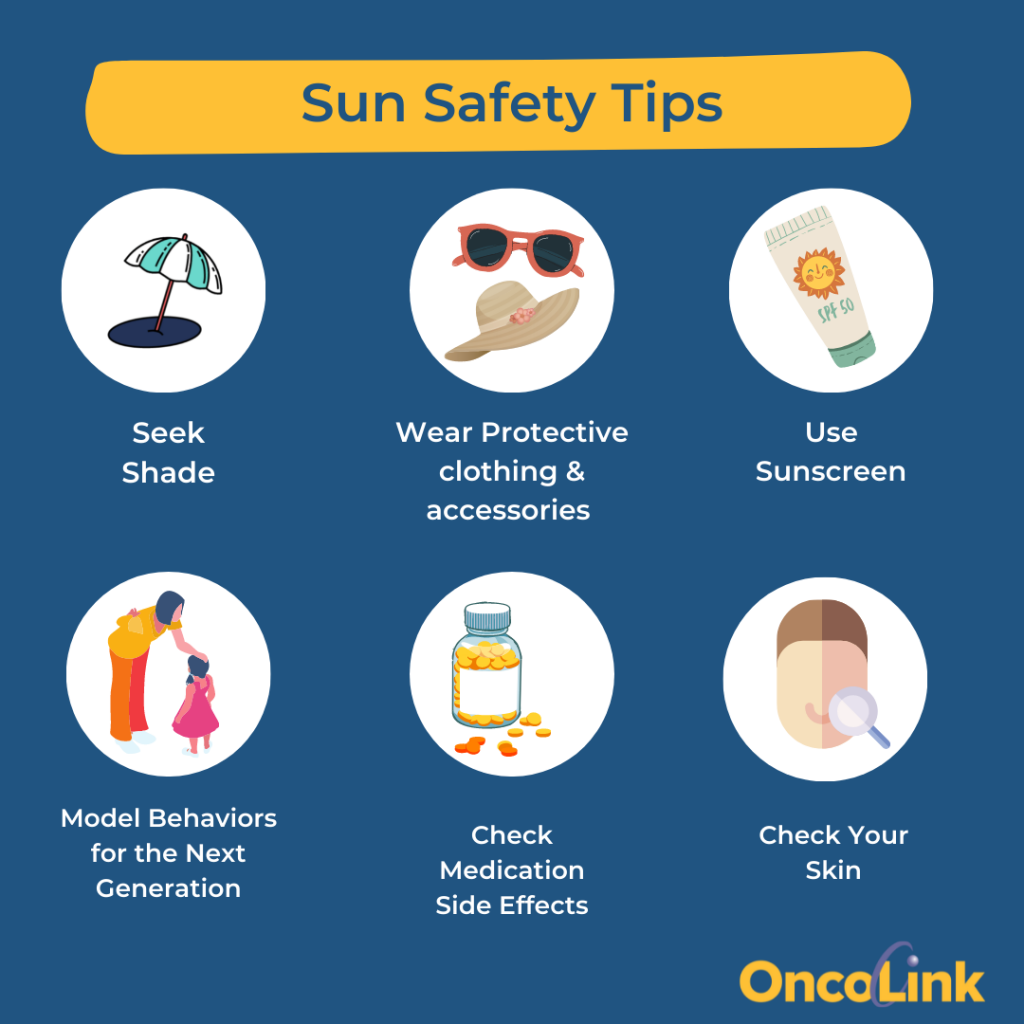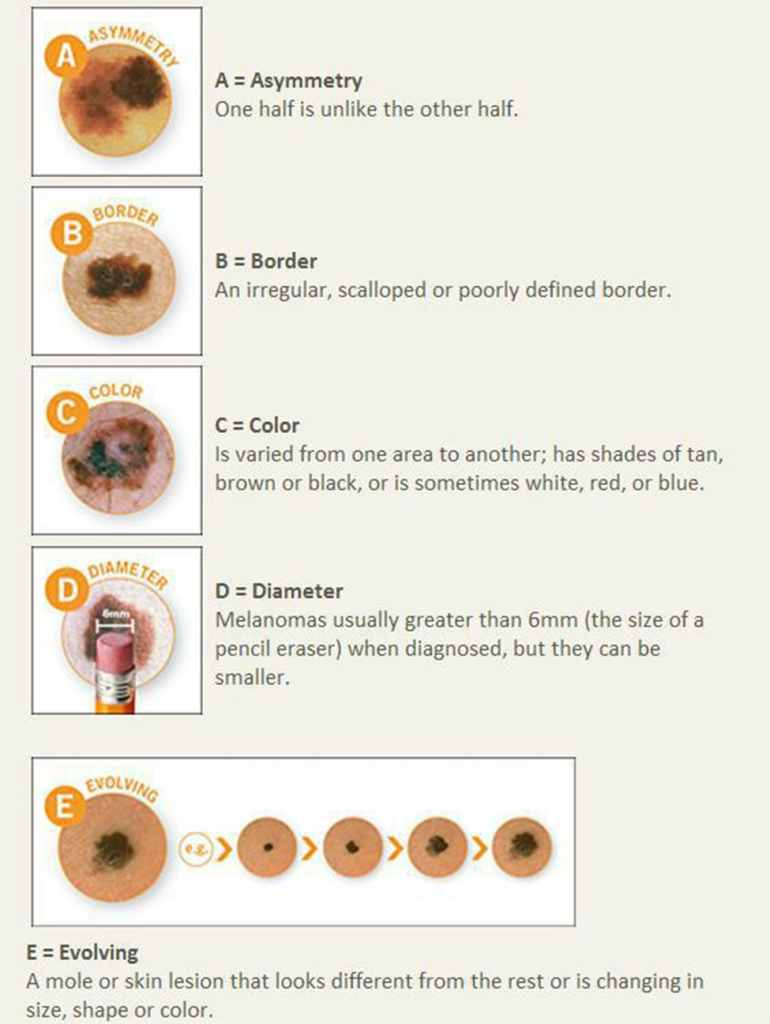
Many of us love the sunshine – but it isn’t always good for us! UV radiation from the sun causes skin damage and aging, cataracts, and skin cancer. Every year there are more new cases of skin cancer than new cases of breast, prostate, lung, and colon cancers combined! Did you know one in five Americans will develop skin cancer in their lifetime?
The end of May is the unofficial start of summer for many. This is a great time to refresh our sun safety practices lowering your risk of skin cancer! Most of us know about SPF and sunscreen, but this should not be your first line (or only) of defense against the sun. Challenge yourself to think about sun safety differently by changing some of your behaviors for the better.
First-line defenses
- Cover your skin – Clothing and hats protect your skin from the sun better than any SPF. Wear a long-sleeve cover-up or rash guard shirt when you’re going to the pool or beach. Choose a big hat- a baseball cap doesn’t offer much protection. Try a bucket-style hat or wide-brimmed hat to get more coverage.
- Don’t forget your eyes – Sunglasses are not just a fashion accessory. They can protect your eyes from UV damage that can lead to cataracts and other eye problems. Look for glasses that offer UV protection – even cheap sunglasses often do.
- Shade is your friend – It may seem simple, but it isn’t always easy to find a shady spot. You must train yourself to look for and find shade whenever possible. Walking down a sunny street- is one side shadier? Going to a kid’s baseball game – how about getting a folding chair with a canopy? Use an umbrella to provide your own shade. Make it a challenge next time you’re out in the sun- can you find a shadier location?
- Avoid the strongest sun hours of 10am to 4pm. Can you do your outdoor activities in the morning or late afternoon avoiding these hours?
Now add sunscreen to the mix

Once you have incorporated all these steps, sunscreen is the next layer of defense. Use a sunscreen that is “broad spectrum” – meaning it protects against UV A & B rays. While there are sunscreens with SPF up to 100, for most people an SPF of 50 is plenty. Studies have shown that using a higher SPF gives people a false sense of security and they think they can be out in the sun much longer. Truth is, it does not last much longer and this results in more sunburns.
Apply your sunscreen 30 minutes BEFORE going outside. How many people are sitting on the beach just getting out the bottle? Reapply every 2 hours – or more often if you are swimming or sweating. This is true even when the product claims to be “waterproof.”
Remember the kids!
If you are of a certain age, you may not have grown up using sunscreen or even thinking about sun safety. But now we know the dangers of our behaviors – the sunburns at the beach, hours on the ballfield without sunscreen, and hours in the pool. We are raising a new generation of kids who can be smarter with our help. Sunburns in childhood can double the chance of developing melanoma, the most serious form of skin cancer.
In addition to sunscreen, we need to teach kids to cover up, seek out shade, and wear hats and sunglasses. Modeling this behavior is a great first step! Getting my 11-year-old to wear a swim shirt is always a fight- until we were on vacation and saw a kid burned so badly that he screamed when his sister touched his shoulder. Kids need concrete examples and unfortunately, this kid was a perfect example. Point out good sun safety behaviors for them too. As your kids get older, they are less and less under your control, but if you have taught them all along, they might surprise you.
Darker skin tones are at risk too!
While skin cancer is more prevalent in those with lighter skin tones, it’s a common misconception that skin cancer only affects white people. Because of this, skin cancers in people of color tend to be diagnosed at a later stage and, as a result, have worse outcomes. It’s important for all communities to practice sun safety and to check their skin for any changes.

Do your medicines make you more sensitive?
There are several medications that make you more sensitive to the sun (called photosensitivity). These include antihistamines, cholesterol-lowering drugs, pain relievers, diabetes medications, antibiotics, retinol creams, and more. Check your labels and check with your pharmacist about possible side effects from any medications you take.
Know your skin
You should know your skin – moles, birthmarks, and other spots. When something looks different, get it checked. The ABCDE acronym can be a guide (see image) – but if something looks new or different, get it checked by a provider. Consider seeing a dermatologist for a complete skin check once a year – especially if you have a history of sun exposure (long term or sunburns), many moles, or skin cancer.
Carolyn Vachani is an oncology advanced practice nurse and the Managing Editor at OncoLink. She has worked in many areas of oncology including BMT, clinical research, radiation therapy, and staff development. She serves as the project leader in the development and maintenance of the OncoLife Survivorship Care Plan and has a strong interest in oncology survivorship care. She enjoys discussing just about any cancer topic, as well as gardening, cooking, and, of course, her sons.